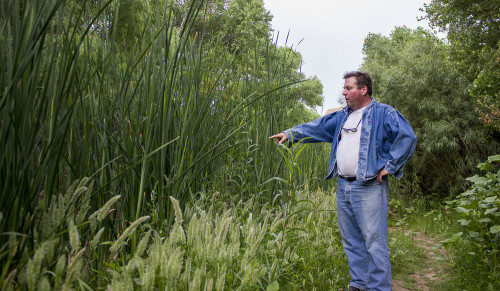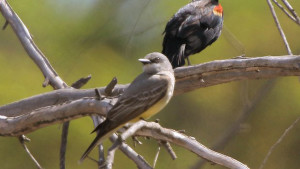
A small bird is part of a big plan to help endangered animals in Arizona.
The Working Lands for Wildlife project is helping private landowners preserve habitats of endangered animals, including the Southwestern willow flycatcher.
The Natural Resources Conservation Service, part of the U.S. Department of Agriculture, and their partner the U.S. Fish and Wildlife Services, launched the program in February to work with farmers and ranchers across Arizona, California, Colorado, New Mexico, Texas and Utah.
The program aids the flycatcher and 85 other species on the cusp of being endangered, such as the Sonora Chub fish.
Stu Tuttle, an Arizona biologist for the conservation service, said getting a landowner’s interest in helping is the main goal.
“We want to keep the interest of the agricultural producers foremost, because if we’re not addressing the private landowners’ needs, then they’re not going to come to the table and participate in the program,” Tuttle said.
They have been primarily working with ranchers, he said.
“In Arizona, we have about a half a dozen contracts (with landowners) right now and we are still ramping that up,” Tuttle said.

Flycatchers live throughout Arizona along streams, riverbanks and other watercourses, building nests in willows and boxelder trees.
Tuttle said they have more than 40 conservation practices for this particular program, such as planting willow trees that attract flycatchers, and removing invasive plants like salt cedar.
Tuttle said they are allowing cattle to graze near rivers throughout the year, but in a controlled manner to protect the flycatchers’ homes.
Langdon Hill, owner of Painted Cave Cattle Ranch in Winkleman, AZ, believes that taking some cattle down to the river area and letting them graze for a certain amount of time helps the plants grow to their full potential. “By having cattle down there doing some controlled maintenance, its just amazing to see how the relationship of the right amount of (cattle) on the land makes the land look great and the animals look great,” Hill said.
Ranchers are installing fences to control their cattle and building water bins away from flycatcher nests, he said.
Steve Spangle, an Arizona field supervisor for U.S. Fish and Wildlife, said the conservation agency provides money or reimburses ranchers to build water bins and fencing.
The budget for the wildlife project is still fairly new. Tuttle estimates it to be around $2 million and it’s still going up. The conservation service gets money from different financial programs, but the biggest is the Environmental Quality Incentives Program, which is funded by taxpayer dollars through the farm bill. The farm bill gave EQIP $1.35 million in 2014, according to the USDA’s Commodity Credit Corporation.
It costs each landowner a different amount to build fencing or other conservation practices depending on their contract, Tuttle said. For example, building a barbed wire fence may cost around $1.32 per-foot, according to the USDA. Prices vary depending on the material and how much it is being used.
Tuttle said they haven’t had much interest from landowners around the areas they want to target, such as the lower San Pedro River and the upper and lower parts of the Gila River. But they do have some contracts with ranchers along the eastern side of the Blue River, some on the west side on Date Creek and in the Kingman area.
One participating landowner is the 86,000-acre O X Ranch near Congress, Arizona, which includes Date Creek.
“We look at it to make a productive environment and ecosystem that fully and best utilizes the productivity of that riparian area for all things of nature,” said Pat Browning, ranch general manager.
Browning is trying to get the word out about the wildlife project and wants his fellow ranchers to realize that maintaining riparian habitats for willow flycatchers and other animals has helped the ranch grow, he said. But it’s not easy.
“It’s a hard sale,” Browning said. “You get old cowboys beatin’ on the table sayin’ my family has had this ranch for 105 years and we don’t need anybody tellin’ us how to run it.”
Tuttle agrees.
“Because they own that land, they bought it, paid for it, they’re paying taxes on it, we don’t want to say to them, ‘well we would like you to save this bird and oh, by the way, you can’t ever use this land again,’” Tuttle said. “We want them to be a part of it and still keep their livestock operations going.”
Sterling Blum is a reporter for Arizona Sonora News, a service from the School of Journalism with the University of Arizona. Contact her at [email protected].

